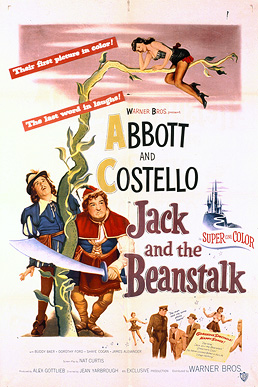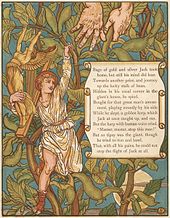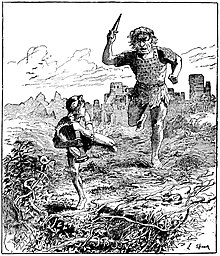
"Jack the Giant Killer" is a Cornish fairy tale and legend about a young adult who slays a number of bad giants during King Arthur's reign. The tale is characterised by violence, gore and blood-letting. Giants are prominent in Cornish folklore, Breton mythology and Welsh Bardic lore. Some parallels to elements and incidents in Norse mythology have been detected in the tale, and the trappings of Jack's last adventure with the Giant Galigantus suggest parallels with French and Breton fairy tales such as Bluebeard. Jack's belt is similar to the belt in "The Valiant Little Tailor", and his magical sword, shoes, cap, and cloak are similar to those owned by Tom Thumb or those found in Welsh and Norse mythology.

"Rapunzel" is a German fairy tale most notably recorded by the Brothers Grimm and published in 1812 as part of Children's and Household Tales. The Brothers Grimm's story was developed from the French literary fairy tale of Persinette by Charlotte-Rose de Caumont de La Force (1698), which itself is an alternative version of the Italian fairy tale Petrosinella by Giambattista Basile.

Fun and Fancy Free is a 1947 American animated musical fantasy anthology film produced by Walt Disney and Ben Sharpsteen and released on September 27, 1947 by RKO Radio Pictures. The film is a compilation of two stories: Bongo, narrated by Dinah Shore and loosely based on the short story "Little Bear Bongo" by Sinclair Lewis; and Mickey and the Beanstalk, narrated by Edgar Bergen and based on the "Jack and the Beanstalk" fairy tale. Though the film is primarily animated, it also uses live-action segments starring Edgar Bergen to join its two stories.

Jack and the Beanstalk is a 1952 American family comedy film starring the comedy team of Abbott and Costello and featuring Buddy Baer, Dorothy Ford and Barbara Brown. It is a comic retelling of the "Jack and the Beanstalk" fairy tale, produced by Abbott and Costello and distributed by Warner Bros.

Revolting Rhymes is a 1982 poetry collection by British author Roald Dahl. Originally published under the title Roald Dahl's Revolting Rhymes, it is a parody of traditional folk tales in verse, where Dahl gives a re-interpretation of six well-known fairy tales, featuring surprise endings in place of the traditional happily-ever-after finishes.
"The Goodies and the Beanstalk" is a special episode of the British comedy television series The Goodies. Written by The Goodies, with songs and music by Bill Oddie.

"Fee-fi-fo-fum" is the first line of a historical quatrain famous for its use in the classic English fairy tale "Jack and the Beanstalk". The poem, as given in Joseph Jacobs' 1890 rendition, is as follows:

Jack and the Beanstalk: The Real Story is a 2001 American television miniseries directed by Brian Henson. A co-production of Hallmark Entertainment and The Jim Henson Company, it is based on the classic English tale "Jack and the Beanstalk". The story was considerably reworked to reflect what Henson believed to be a more ethical, humanist view. The cast includes Matthew Modine, Mia Sara, Jon Voight, and Vanessa Redgrave. Richard Attenborough, Daryl Hannah, and James Corden play giants.
Benjamin Tabart (1767–1833) was an English publisher and bookseller of the Juvenile Library in New Bond Street, London. Many of the books in his list were written by himself. In an age of strictly moralizing children's literature, he broke ground with his fairy tales and light-hearted nursery stories and chapbook tales. His is the first printed version (1804) of the tale of Jack and the Beanstalk.

Giantland is a 1933 animated short film produced by Walt Disney Productions and distributed by United Artists. The film is an adaptation of the fairy tale "Jack and the Beanstalk" with Mickey Mouse in the title role. Mickey is voiced by Walt Disney and Mickey's nephews are voiced by Marcellite Garner, who at the time usually voiced Minnie Mouse. It was the 62nd Mickey Mouse short film, and the twelfth of that year.
Jack and the Beanstalk is a 1931 Fleischer Studios Talkartoon animated short film starring Bimbo and Betty Boop.

Jack and the Beanstalk is a 1974 Japanese animated feature film produced by Group TAC and Nippon Herald Films and directed by Gisaburō Sugii. Styled after classical Western animation, it is a musical fantasy based on the fairy tale of the same name with the screenplay by Shūji Hirami, music organization by Yū Aku and songs and score composed and arranged by Takashi Miki with Shun'ichi Tokura and Tadao Inōe. It was released in Japan on July 20, 1974 and in the United States by Columbia Pictures in 1976.

Jack and the Beanstalk is a 1902 American silent trick film directed by George S. Fleming and Edwin S. Porter. With ten sequential shots, Jack and the Beanstalk was twice as long as any previous studio film. According to Porter, "It took in the neighborhood of six weeks in the spring of 1902 to successfully make this photograph."
"Tiny" is the 13th episode of the second season of the American ABC fantasy/drama television series Once Upon a Time, and the show's 35th episode overall, which aired on February 10, 2013.
"Grimm Job" is the tenth episode of the twelfth season of the animated comedy series Family Guy and the 220th episode overall. It originally aired on Fox in the United States and Canada on January 12, 2014, and was directed by Joe Vaux and written by Alec Sulkin.

Jack the Giantkiller is a 1982 arcade game developed and published by Cinematronics. It is based on the 19th-century English fairy tale "Jack and the Beanstalk". In Japan, the game was released as Treasure Hunt. There were no home console ports.

Revolting Rhymes is a 2016 British computer-animated fantasy comedy drama television film written for the screen and directed by Jakob Schuh and Jan Lachauer, based on the 1982 book of the same name written by Roald Dahl and illustrated by Quentin Blake.
Jack and the Beanstalk is a 1967 live-action/animated-hybrid musical-themed telefilm that was produced and directed by and starred Gene Kelly. It was produced by William Hanna and Joseph Barbera. It is a retelling of the popular fairy tale that mixes both live action and animation. The film premiered on NBC, on February 26, 1967.

Jack and the Beanstalk is a 2009 American fantasy adventure comedy film directed by Gary J. Tunnicliffe, from a story based on the classic fairy tale of the same name. The film stars an ensemble cast led by Colin Ford, Gilbert Gottfried, Christopher Lloyd, Chloë Grace Moretz, Wallace Shawn, Katey Sagal, James Karen, Daniel Roebuck, Madison Davenport, and James Earl Jones.
Jack and the Beanstalk is a 1933 animated short film directed by Ub Iwerks and part of the ComiColor cartoon series.


















